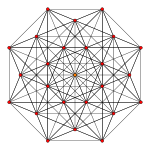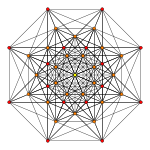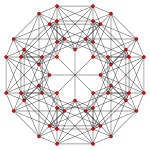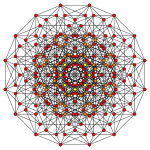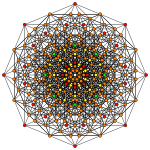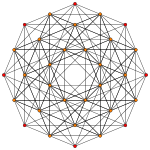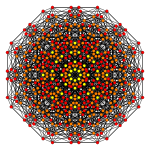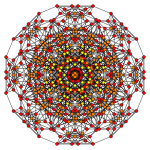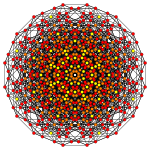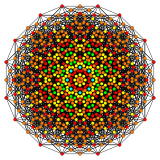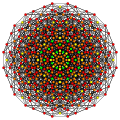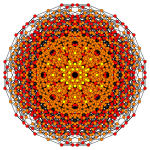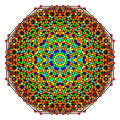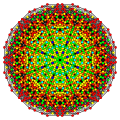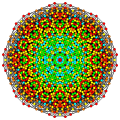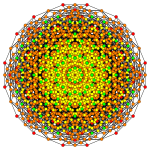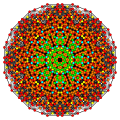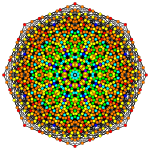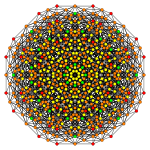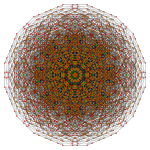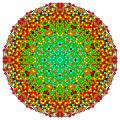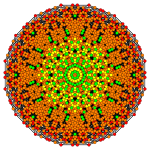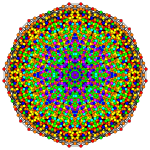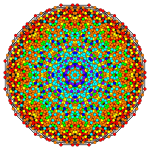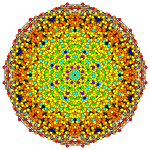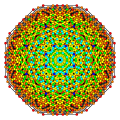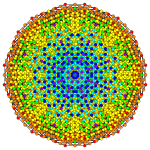7-simplex
| Regular octaexon (7-simplex) | |
|---|---|
 Model created using straws (edges) and plasticine balls (vertices) in triakis tetrahedral envelope | |
| Type | Regular 7-polytope |
| Family | simplex |
| Schläfli symbol | {3,3,3,3,3,3} |
| Coxeter-Dynkin diagram | |
| 6-faces | 8 6-simplex |
| 5-faces | 28 5-simplex |
| 4-faces | 56 5-cell |
| Cells | 70 tetrahedron |
| Faces | 56 triangle |
| Edges | 28 |
| Vertices | 8 |
| Vertex figure | 6-simplex |
| Petrie polygon | octagon |
| Coxeter group | A7 [3,3,3,3,3,3] |
| Dual | Self-dual |
| Properties | convex |
In 7-dimensional geometry, a 7-simplex is a self-dual regular 7-polytope. It has 8 vertices, 28 edges, 56 triangle faces, 70 tetrahedral cells, 56 5-cell 5-faces, 28 5-simplex 6-faces, and 8 6-simplex 7-faces. Its dihedral angle is cos−1(1/7), or approximately 81.79°.
Alternate names
It can also be called an octaexon, or octa-7-tope, as an 8-facetted polytope in 7-dimensions. The name octaexon is derived from octa for eight facets in Greek and -ex for having six-dimensional facets, and -on. Jonathan Bowers gives an octaexon the acronym oca.[1]
Coordinates
The Cartesian coordinates of the vertices of an origin-centered regular octaexon having edge length 2 are:
More simply, the vertices of the 7-simplex can be positioned in 8-space as permutations of (0,0,0,0,0,0,0,1). This construction is based on facets of the 8-orthoplex.
Images
| Ak Coxeter plane | A7 | A6 | A5 |
|---|---|---|---|
| Graph |  |
 |
 |
| Dihedral symmetry | [8] | [7] | [6] |
| Ak Coxeter plane | A4 | A3 | A2 |
| Graph |  |
 |
 |
| Dihedral symmetry | [5] | [4] | [3] |
Related polytopes
This polytope is a facet in the uniform tessellation 331 with Coxeter-Dynkin diagram:
This polytope is one of 71 uniform 7-polytopes with A7 symmetry.
Notes
- ↑ Richard Klitzing, 7D uniform polytopes (polyexa), x3o3o3o3o3o - oca
External links
- Glossary for hyperspace, George Olshevsky.
- Polytopes of Various Dimensions
- Multi-dimensional Glossary
| Fundamental convex regular and uniform polytopes in dimensions 2–10 | ||||||||||||
|---|---|---|---|---|---|---|---|---|---|---|---|---|
| Family | An | BCn | I2(p) / Dn | E6 / E7 / E8 / F4 / G2 | Hn | |||||||
| Regular polygon | Triangle | Square | p-gon | Hexagon | Pentagon | |||||||
| Uniform polyhedron | Tetrahedron | Octahedron • Cube | Demicube | Dodecahedron • Icosahedron | ||||||||
| Uniform polychoron | 5-cell | 16-cell • Tesseract | Demitesseract | 24-cell | 120-cell • 600-cell | |||||||
| Uniform 5-polytope | 5-simplex | 5-orthoplex • 5-cube | 5-demicube | |||||||||
| Uniform 6-polytope | 6-simplex | 6-orthoplex • 6-cube | 6-demicube | 122 • 221 | ||||||||
| Uniform 7-polytope | 7-simplex | 7-orthoplex • 7-cube | 7-demicube | 132 • 231 • 321 | ||||||||
| Uniform 8-polytope | 8-simplex | 8-orthoplex • 8-cube | 8-demicube | 142 • 241 • 421 | ||||||||
| Uniform 9-polytope | 9-simplex | 9-orthoplex • 9-cube | 9-demicube | |||||||||
| Uniform 10-polytope | 10-simplex | 10-orthoplex • 10-cube | 10-demicube | |||||||||
| Uniform n-polytope | n-simplex | n-orthoplex • n-cube | n-demicube | 1k2 • 2k1 • k21 | n-pentagonal polytope | |||||||
| Topics: Polytope families • Regular polytope • List of regular polytopes | ||||||||||||







